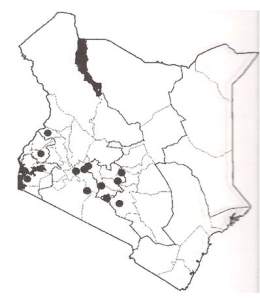Scientific name
Cupressus lusitanica
Order / Family
Cupressaceae
Local Names
Kikuyu (Mutarakwa); Kisii (Omobakora); Luhya (Mudarakwa); Luo (Obudo)
Introduction
General Distribution:
It originated from the moist mountain forests of Mexico, in Belize, Costa Rica, El Salvador, Guatemala, Honduras, Mexico, Nicaragua, Panama and US. It was introduced in Kenya before 1910 and is distributed as in the map below;
 |
| Distribution of Cupressus lusitanica in Kenya |
| © Maundu P. and Bo Tengnas. (2005). Useful trees and shrubs for Kenya, World Agroforestry Centre. |
General Information about the Tree:
Cupressus lusitanica is also very good at making live fences. It is planted closely together and then trimmed.
Biophysical Limits:
Altitude: 1000 - 4000 m,
Mean annual temperature: 12-30 deg. C,
Mean annual rainfall: 800 - 1500 mm
Soil type: C. lusitanica flourishes in deep, moist, well-drained, fertile loams of neutral to slightly acidic reaction.
Mean annual temperature: 12-30 deg. C,
Mean annual rainfall: 800 - 1500 mm
Soil type: C. lusitanica flourishes in deep, moist, well-drained, fertile loams of neutral to slightly acidic reaction.
Propagation and Tree Management
Seedlings are used to propagate it. Cupressus lusitanica is fast growing on good sites and moderate on poorer sites. Prune and thin trees in woodlots if objective is good quality timber. It does not coppice well. Occurs in plantations and on boundaries
Products:
- Fuel: C. lusitanica is a good source of firewood light charcoal.
- Timber: It is a source of construction wood and pulp wood and is used for furniture, poles and posts.
Services:
- Shade or shelter: Trees are suitable as windbreaks.
- Ornamental: The beautiful tree can be planted in amenity areas.
- Boundary or barrier or support: It is grown as a live fence.
Pests and Diseases
Trees are susceptible to insect pests Acheta assimilis, Agrotis spp., Atta spp., Captotermes crassus, Exophthalmus spp., Phytophaga spp., Platypus spp. and Pypselonotus aratus. The pest most widely known is the timber borer Oemida gahani, which gains entry through surface wounds such as those created by pruning and degrades timber; pruning before trees are 7 years old could contain the problem. The cypress aphid Cinara cupressi attacks trees of the Cupressaceae family in south and central Africa and is fast advancing to Tanzania and Uganda. Pests are controlled using insecticides and biological control techniques, by planting resistant varieties and by legislation prohibiting entry of plant material from infested areas.
The most serious diseases are those affecting cambial function and other tissues. In misty and wet weather, trees are susceptible to fungal attack by Monochoetia unicornis. It infects stems of young plants and young shoots of older trees and appears as cankers and local disorganization of newly formed bark, cambial and cortical tissues. Armillaria root rot caused by Armillaria mellea attacks roots and butts of trees and causes rotting, which eventually kills the trees. Pathogens that attack trees include Cercospora seqoiae, Colletotrichum spp., Fusarium spp., Seridium cardinaleand Verticillium.
Information Source Links
- Maundu P. and Bo Tengnas (2005). Useful trees and shrubs for Kenya, World Agroforestry Centre.
- www.worldagroforestry.org
